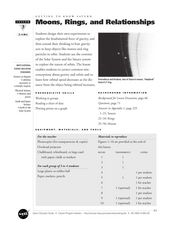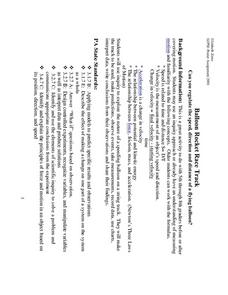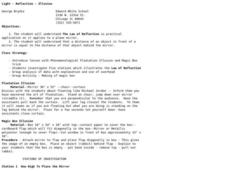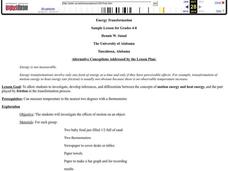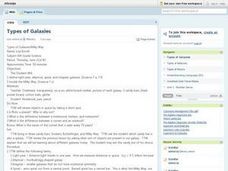Cornell University
Nano Interactions
Tiny particles can provide big learning opportunities! Middle school scientists explore the world of nanoparticles through reading, discussion, and experiment. Collaborative groups first apply nanotechnology to determine water...
Curated OER
Everyday Objects: Eskimo Life
Students describe the pioneering work of researcher Edward W. Nelson and identify everyday objects that aid in understanding a culture. In this everyday objects lesson, students conduct their own research into everyday objects by...
Curated OER
Everyday Objects
Students investigate different cultures based on the everyday objects of that culture. First, they explore Edward W. Nelson, who explored the Alaska region and first learned about the Eskimo culture.
Curated OER
Finding Volume
Sixth graders develop a rule for finding the volume of rectangular solids using colored cubes. They investigate the properties of solid figures and find the volume of an object by counting units. Students fill spaces with standard-sized...
Curated OER
Getting to Know Saturn: Moons, Rings, and Relationships
Students identify the different objects that orbit Saturn. In this space science lesson, students plot the graph of orbital speed and distance. They explain why planets and asteroids remain in orbit around the sun.
Mathematics Vision Project
Module 5: Modeling with Geometry
Solids come in many shapes and sizes. Using geometry, scholars create two-dimensional cross-sections of various three-dimensional objects. They develop the lesson further by finding the volume of solids. The module then shifts...
Curated OER
Meet the Plants
Students examine the difference between living and non-living things. In this living versus non-living lesson plan, students complete a KWL worksheet and a Living and Non-Living Chart. They examine a variety of plants and non-plants...
Curated OER
My Angle on Cooling
Students explore how the angle and distance of an object can change it's temperature. After reviewing how the position of the Earth affects the temperature of the planet, student groups design and perform an experiment to test how...
Curated OER
Natural Selection Day 1
Students define the concept of classification. In groups, they categorize a series of objects into categories they identify. As a class, they participate in a variety of activities to examine the concept of natural selection. To end...
Curated OER
Balloon Rocket Race Track
Students discuss "How can we measure (or make it easier to record) the speed, distance or acceleration of the balloon?" They told that they are going to make a balloon racetrack. Pupils use meter sticks to accurately measure length and...
Curated OER
Density And Volume
Sixth graders explore the concept of density as a relationship of an object's mass to its volume. Densities of a variety of objects are compared and used to identify an unknown object.
Curated OER
A Taste of Our Classroom
Young scholars explore their classroom tastes. For this lesson plan, students list the four tastes that the tongue can detect, map the individual areas of taste on the tongue, and demonstrate the ability to identify objects through the...
Curated OER
Displacement of fluids
Students understand the meaning of volume. In this displacement of liquid lesson, students experiment with various weights and a balance scale to find the liquid displaced.
Curated OER
Light - Reflection - Illusion
Students experience the magic of mirrors. In this reflection and illusion lesson plan, students witness magic tricks that work because of mirrors, then rotate through five stations to complete hands-on experiments using mirrors, light,...
Curated OER
Energy Transformation
Students experiment with variety of materials to investigate, develop inferences, and differentiate between concepts of motion energy and heat energy, and the part played by friction in the transformation process.
Curated OER
Measurement
Learners explore the necessity for standards of measurement and measure length, volume, mass and angles. In this measurement lesson plan, students use their hand and foot to measure objects in the room. They compare their measurements to...
Curated OER
The Power of Atmospheric Pressure Process
Students are introduced to the basic principles of atmospheric pressure. After watching demonstrations, they discover the capability of air pressure and how it affects weather. In groups, they use an inquiry template to solve different...
Curated OER
Types of Galaxies
Eighth graders take a quiz to review the different objects in space. As a class, they define terms related to galaxies. In groups, they make a model of the Milky Way galaxy using materials provided to them by their teacher. To end the...
Curated OER
The Five Senses
Students explore the 5 senses. In this biology lesson plan, students demonstrate the ability to identify objects through the use of the five senses as they complete 5 activities.
Curated OER
Investigating: Finding the Volume
Sixth graders explore geometry by utilizing colored cubes in class. In this volume lesson, 6th graders identify the different shapes they can create using their colored cubes and identify the formula for finding volume. Students create...
Curated OER
2D Kinematics w/ String Racers
Students calculate the speed of string racers. In this physics instructional activity, students measure the time in several trials and get the average. They graph their results using a spreadsheet.
Curated OER
Mechanism of Vision
Students explore the eye and its vision. In this science lesson plan, students learn the way light reflected from objects enters the eye, the basic anatomy and physiology of the eye, and the basic mechanism of perception.
Curated OER
Potential and Kinetic Energy
Fifth graders explore how energy changes from one form to another within their surroundings. They explore how kinetic and potential energy relate to each other and the ability to do work. Students observe example of both kinetic and...
Curated OER
Friction Faction
Students create an experiment. In this friction lesson plan, students review the concept of friction and complete a bottle roll activity. Students work in groups to create their own friction experiment.




